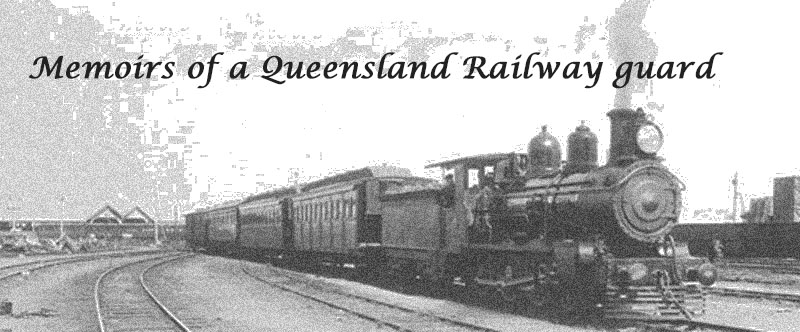|
|
|
|
Introduction PART 1: BYRNES FAMILY ANCESTORS’ CHARTS : (Parents of Peter Byrnes): INDIVIDUAL SUMMARIES
|
The Queensland Times, Saturday Oct. 18, 1952: Railway Service A Guard’s Experiences – 3 (by T.A. Byrnes) Taking up guard’s duties again the Ipswich district depot, after being about five years on the Fassifern branch..… I realised that the work was somewhat different on the main line runs to Toowoomba from Ipswich, on which the train known at 16 up left Ipswich shortly before noon. The work on the train began at Rosewood. At every station to Murphy’s Creek, wagons were detached and picked up, also there was a fair amount of roadside goods to handle. This train generally arrived at the Toowoomba yards between 10 o’clock and 11 o’clock. A light engine was always sent down from Toowoomba to Murphy’s Creek to bank this train over the Main Range. The handling of traffic was facilitated better between Ipswich and Helidon, except from Grandchester to 48 miles (Yarongmulu Staff Station) than previously, owing to the double line. The double line from Ipswich to Helidon was opened for traffic in March 1919. The length of the tunnel at the top of the Little Liverpool Range is 27 chains. Mr James Matthews, who was Chief Assistant Stationmaster at Ipswich while I was stationed on the Fassifern branch, was transferred to Toowoomba as Chief Assistant Stationmaster, and the guard had to report to him on the late running of trains. The late Mr Matthews was a much respected official among trainmen. ACCOMMODATION FOR TRAINMEN After arriving at Toowoomba, the trainmen (guards, drivers and firemen) made their way to the large and well-equipped quarters near the Toowoomba station. I recall that in those days 20 or 30 trainmen were at the quarters at a time. Men came from the western depots and Warwick. In the large kitchen were always two stoves burning night and day, and each bedroom had two beds. Those days the men worked in real harmony with one another and some good tales were told while having midnight meals. Today, at this Toowoomba quarters, the scene is quite different. The drivers and firemen camp after a long run at Willowburn, and Ipswich trainmen rarely go past Gatton or Granthm. There is a system of changing trains there with the Toowoomba men, and trainmen return to their home depots at night. On the return trip of 16 up in those days, the train was known as 33 down. It departed from Toowoomba next day about 10.30am, and the routine of the work was the same as on the up journey. Exceptionally heavy loading of produce was taken on for the Brisbane markets. I remember when arriving at Laidley, there was a large trainload of produce, also livestock from the Laidley cattle yards off the Mulgowie branch. Bob Grier was stationed at guard at Laidley for a good number of years, and the banking engine worked trains on this branch. The Mulgowie branch was opened for traffic on April 19, 1911. When this branch was first opened, Ipswich trainmen left Ipswich about midday and returned the same night to Ipswich. I would also like to mention that this train (33 down) attached the wagons at Helidon carrying Helidon freestone for the new City Hall in Brisbane. Huge blocks of beautiful freestone from the Helidon quarries were on the trains. The official opening of ths Brisbane City Hall was in July 1930. YARRAMAN BRANCH Another long distance run I often did was to Yarraman. A regular mixed train known as 30 up departed from Ipswich at 10.20 pm with passenger accommodation, and arrived at Yarraman about 7.30am. After arriving at Yarraman, the trainmen were detained, shunting the pine company’s sidings for about 90 minutes. There were quarters at Yarraman, and they were well looked after by an attendant. The return journey was started at 8.10 the same night. All the stations’ loading was picked up as far as Esk, then the trains did no more shunting. Extra carriage accommodation was also on this train known at 21 down. A 20 minute stop was made at Esk for the passengers to take a meal. The train arrived at Esk about 1 o’clock in the morning, and Mrs Campbell, who was in charge of the refreshment rooms had a small staff for the supply of refreshments to the passengers. This refreshment room was not run by the department. Private tender was always called for the lease. The train arrived at Ipswich at 5.30am. |
